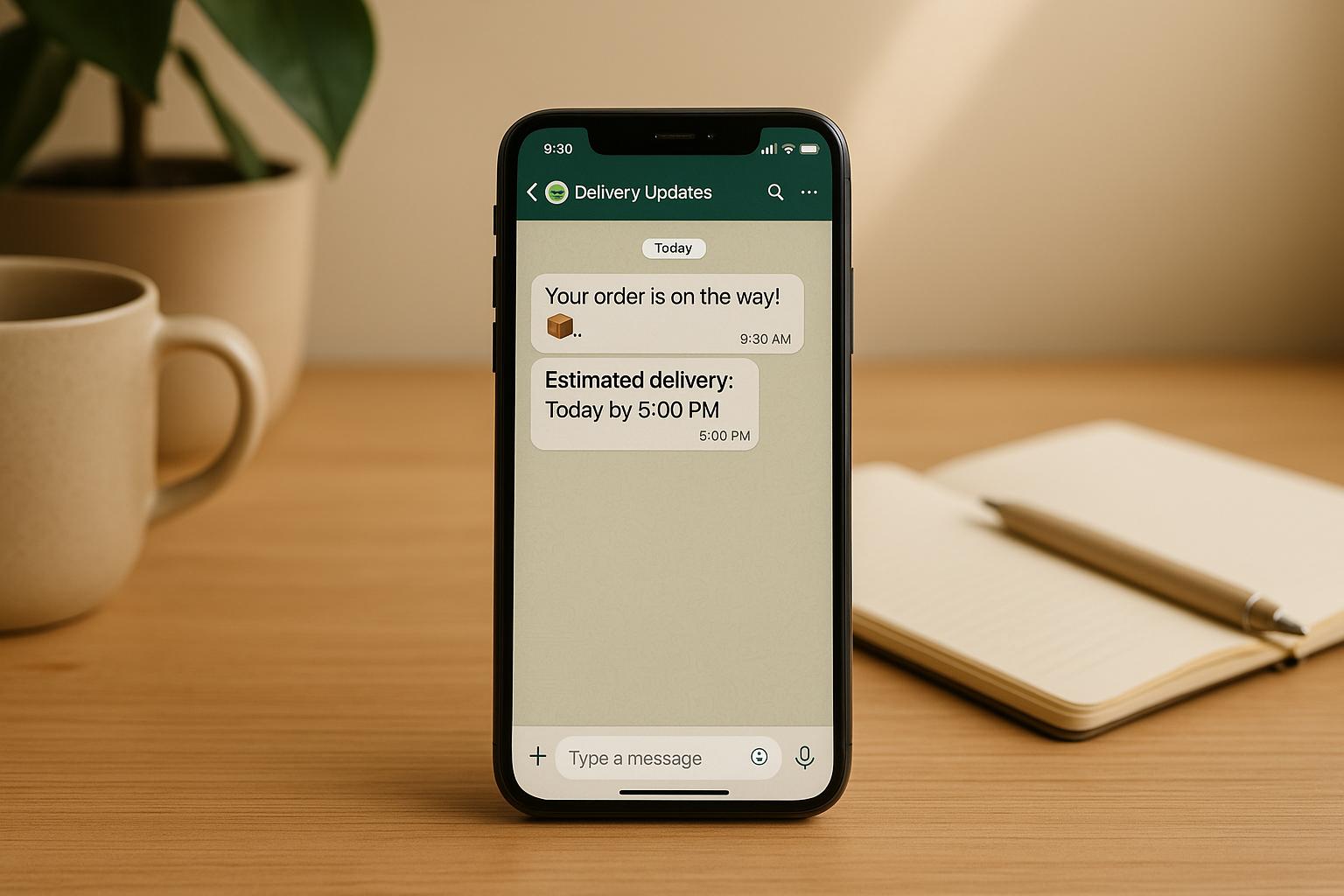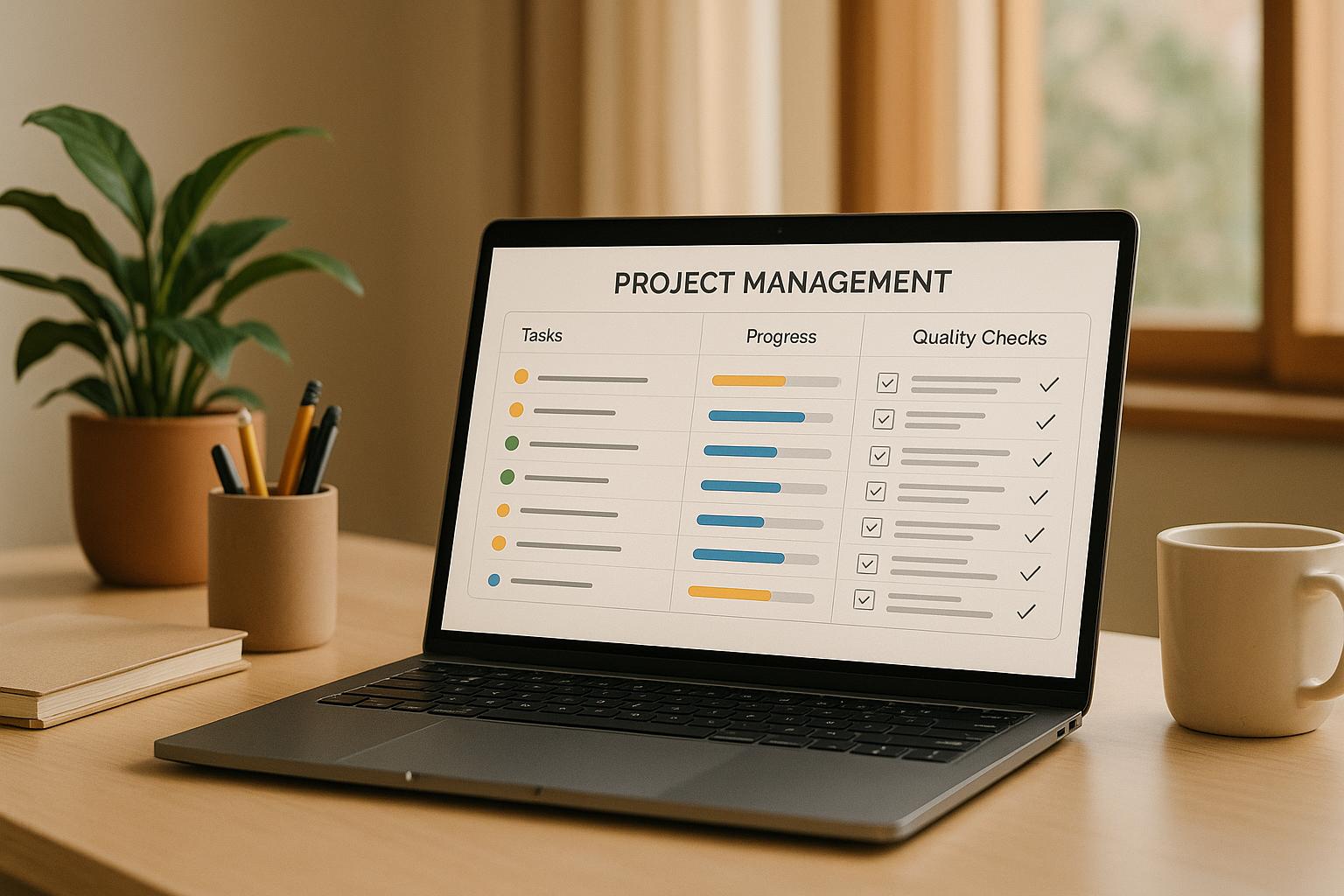Managing project dependencies doesn’t have to be complicated. The key is simplicity - use tools your team already knows, communicate clearly, and focus on what truly matters. Here’s how you can keep projects on track without relying on overly complex systems:
- Spot dependencies early: Break tasks into smaller parts and identify what relies on what. Use tools like network diagrams or Gantt charts to visualize connections.
- Use simple tools: Kanban boards, spreadsheets, or shared documents work well for tracking tasks and their relationships. Add labels, colors, or icons to highlight priorities and bottlenecks.
- Communicate effectively: Regular check-ins and clear communication channels ensure everyone stays aligned. Use direct messaging platforms for updates and approvals.
- Streamline approvals: Tools like Workproofs.com simplify proof-of-work submissions and approvals, reducing delays and keeping deliverables on track.
Mastering Project Dependencies | Episode 515
How to Find and Identify Dependencies
Dependencies are the links between tasks, people, and resources that determine how and when work gets done. These connections play a crucial role in shaping project budgets, timelines, resource planning, and risk management [1]. Ignoring them can lead to delays and unexpected costs.
Dependencies can be obvious, like waiting for a specific task to finish, or less noticeable, such as needing approvals or critical information. To avoid surprises, take the time to thoroughly evaluate each task for both visible and hidden connections.
How to Spot Dependencies Early
Detecting dependencies early requires a structured approach during the planning phase. Start by breaking your project into smaller components, then examine how these pieces relate to one another. For each task, ask if it relies on another task or input to move forward [1]. For instance, a designer can't finalize a brochure without approved text, just as construction crews can't proceed until electrical work is completed.
Using a network diagram can make the critical path clearer [1]. This type of visual map shows the relationships between tasks and highlights which ones could derail the schedule if delayed. Similarly, organizing tasks based on their dependencies - whether sequential, parallel, or delayed-start - provides a clearer picture of how the project will flow.
"There are a number of ways to identify project dependencies. One way is to use your project schedule and identify which tasks are dependent on other tasks being completed first. Another method is to look at the project resources and identify which resources are constrained and how that affects the next steps. Additionally, you can look at the project risks and identify where they might have an impact on your project schedule or resource dependencies." – Lee Dobson, Head of Client Services at Bulldog Digital Media [1]
A detailed review of task requirements can also help uncover hidden dependencies, ensuring everything aligns with the project’s goals and scope. Tools like Kanban boards or Gantt charts are particularly helpful in visualizing the project’s stages and showing how tasks depend on one another [1].
Once you've identified dependencies, maintaining clear and consistent communication is essential to managing them effectively.
The Role of Communication in Dependency Management
After mapping out dependencies, ongoing communication ensures that any new or overlooked connections are addressed quickly. Engage with everyone involved - team members, stakeholders, partners, and customers - to surface dependencies that might not be immediately apparent from task lists alone. Establish clear communication protocols, especially for remote teams, to minimize confusion and ensure everyone stays on the same page. Encouraging open and frequent communication can be key to uncovering subtle dependencies.
"Define processes clearly! This is the best way to avoid misunderstanding. An extensive knowledge base full of guides and how-to's helps employees to familiarize themselves with the structures and approaches of the company. Communication Guidelines explain what tone and channel to use for every message they want to share." – Jessica Traupe, Content & SEO Marketing Manager of Zammad
Regular feedback sessions and an open-door policy (even virtually) can help identify new or hidden dependencies as the project progresses. Training team members in active listening during meetings is another way to ensure important details aren’t overlooked. Keep in mind that dependencies can evolve as projects grow, team members rotate, or external factors change. By maintaining consistent check-ins and fostering clear communication, you’ll be better equipped to address these shifts before they disrupt your project.
Simple Methods for Dependency Tracking
Once you've pinpointed your project dependencies, the next step is to keep them organized and visible. The best way to do this? Stick to simple, user-friendly tools that everyone on your team can easily access and update. Rather than diving into overcomplicated systems, focus on methods that emphasize clarity and allow for frequent updates. This way, your tracking system remains practical and keeps your team aligned without unnecessary hassle.
Using Visual Tools Like Kanban Boards or Whiteboards
Kanban boards are a fantastic way to make dependencies clear and visible for everyone. Whether you opt for a physical board or a digital one, their visual layout helps team members quickly grasp how tasks are interconnected.
To get the most out of your Kanban board, establish clear relationships between task cards. For example, you can use parent-child links to show how tasks flow together. For external dependencies - like waiting on client feedback or vendor deliveries - use icons or labels (such as a "blocked" symbol) to highlight these constraints immediately.
"It's the sequencing of tasks, work, steps, or processes that make dependencies manageable by Agile teams. Identifying dependencies and visualizing them allows everyone involved to better align and prioritize their portion of the work to optimize flow." – Planview
Color coding can also be a game-changer. Use different colors to represent various types of dependencies, and organize tasks into distinct swimlanes to separate those involving external teams. Place dependent tasks in prominent positions on the board to ensure they get the attention they need.
Another pro tip: Regularly review your board during daily stand-ups. These quick check-ins help identify potential bottlenecks before they escalate. Encourage team members to update task statuses and dependencies as they work, and consider adding time buffers to tasks with complex dependencies to minimize risks.
For a more detailed visual map of external dependencies, try using a Dependency Spider diagram. It’s a great way to chart out relationships and spot potential issues at a glance.
If a Kanban board isn’t the right fit for your team, spreadsheets can be just as effective.
Using Spreadsheets and Shared Documents
Spreadsheets are a straightforward yet powerful option for tracking dependencies, especially for remote teams that need a centralized source of information. The key is to design a smart structure and keep it updated consistently.
Start by identifying what information you need to track. Set up clear columns for details like task name, dependency type, responsible person, due date, and status. Use dropdown menus to standardize updates and reduce confusion.
For a broader view, you can create a Dependency Matrix. In this setup, list teams or individuals in the rows and potential sources of delays in the columns. This grid format makes it easier to spot connections that might not stand out in a traditional task list.
To keep things tidy, separate reference data - like team contact info or approval processes - into different tabs. This prevents accidental changes to critical data while keeping your active tracking sheet clean and focused.
Always aim for a single source of truth. If a task shows up in multiple projects, link back to a master entry instead of duplicating information. Also, make sure to timestamp updates so you can track when changes were made.
Whether you’re using a Kanban board or a spreadsheet, daily updates are essential for keeping your tracking system accurate and reflective of your project’s current status.
Simple Communication and Approval Workflows
Tracking dependencies effectively goes beyond just organizing tasks - it's about fostering clear communication that keeps everyone on the same page and accountable. For teams working with subcontractors, remote workers, or individuals less familiar with technical tools, simple solutions can make all the difference in keeping dependencies visible and manageable. Let’s dive into how direct messaging platforms can simplify real-time updates.
Using Direct Messaging Tools for Quick Updates
Platforms like WhatsApp, email, and team chat apps provide an easy way to track and discuss dependencies without requiring your team to learn complicated software. These tools are already widely used, making them accessible and easy to adopt. That said, it’s important to establish clear guidelines for how these channels are used, including response times and communication tone.
On average, workers spend nearly 20 hours a week using digital communication tools, with 45% reporting that these tools help them feel more connected to their team. However, there’s a downside: 60% of workers feel burned out by digital communication, and 42% struggle with stress when trying to convey the right tone. To make things smoother, dedicated channels for dependency management can help streamline updates. For instance, a marketing team might use Slack to document brainstorming sessions, while a finance team might rely on Microsoft Teams for real-time budget discussions. For teams that lean toward asynchronous communication, tools like email, shared documents, or discussion forums work just as well.
Direct messaging tools also shine when it comes to sharing files - whether it’s documents, images, or videos. Cultivating a feedback-friendly environment ensures that any issues with dependencies are addressed early, preventing them from snowballing into bigger problems. For handling dependency approvals, specialized tools like Workproofs.com take things a step further.
Managing Approvals with Workproofs.com

When proof-of-work submissions are part of the process, tools like Workproofs.com simplify approvals and save time. This platform is designed to eliminate bottlenecks by integrating with WhatsApp - a service most people are already familiar with. Subcontractors can submit photos, files, or text directly from their phones without needing to download additional apps, create accounts, or undergo training.
Approvals are reduced to a single tap, allowing managers to quickly approve work or request changes while maintaining a clear audit trail. For teams managing external dependencies, Workproofs.com ensures deliverables meet expectations before moving forward, minimizing errors and safeguarding client relationships. This streamlined approach helps keep projects on track and ensures smoother collaboration.
sbb-itb-57e8e01
Best Practices for Long-Term Dependency Management
Managing dependencies effectively over time requires sticking to straightforward routines that keep small issues from snowballing into major obstacles. These practices build on earlier strategies for identifying dependencies early and tracking them efficiently.
Regular Updates and Check-Ins
Frequent reviews are key to avoiding backlogs and minimizing technical debt. As one expert explains:
"Maintaining dependencies on a regular basis makes the corresponding updates manageable. If you update your dependencies often, there will be less packages to update with smaller version bumps. In my experience, this results in a reduced sense of analysis paralysis."
- skylerlemay.com
Setting aside a consistent block of time - like one hour a week - can help ensure updates happen regularly. This predictable routine not only keeps dependencies up to date but also allows teams to communicate any delays or changes, helping everyone adjust their schedules accordingly.
"I recommend spending 1h on dependency upgrades every week. Especially if you're working with a legacy codebase full of outdated packages!"
- Nicolas Carlo
Keep It Simple and Clear
Once a regular update routine is in place, clear and concise documentation becomes essential. Recording details like dependency versions, their purposes, and any special considerations makes onboarding, troubleshooting, and future updates much more manageable.
The most effective systems are those that fit seamlessly into your team’s existing workflow. For example, if your team already uses WhatsApp for communication, tools like Workproofs.com can integrate easily without requiring extensive training. Similarly, if your team prefers visual organization, basic Kanban boards or spreadsheets often work better than overly complex project management tools.
Planning ahead to replace or update outdated dependencies is equally important. Doing so helps avoid disruptions during critical stages of a project. Assigning a dedicated team member to oversee dependency management can also reduce confusion and ensure progress is tracked efficiently.
Conclusion: Keeping Teams Aligned Without Complexity
Sometimes, the simplest tools are the most effective for tracking dependencies. Consider this: office workers lose about 69 days a year to mundane tasks, and repetitive work racks up a staggering $5 trillion in global costs annually. This highlights a crucial point - more complex software isn’t always the answer. Smarter, more straightforward workflows often achieve better results.
There’s also a surprising gap between how aligned teams think they are and the reality. While 82% of employees believe their organization is strategically aligned, the actual alignment sits at just 23%. Why? Overly complicated processes tend to blur responsibilities and obscure dependencies, making it harder for teams to work in sync.
The solution lies in clarity and simplicity. Tools like visual boards, shared spreadsheets, or even direct messaging apps can make a big difference. When team members clearly see how their tasks connect to others, alignment improves naturally. Importantly, the best methods don’t force teams to adopt entirely new systems - they fit seamlessly into existing workflows. For example, Workproofs.com demonstrates how streamlined approval processes can eliminate bottlenecks without adding unnecessary complexity. By leveraging familiar tools like WhatsApp, teams can track dependencies and manage approvals without disrupting their usual communication habits.
The most effective dependency tracking systems share a few key traits: they make processes transparent, reduce manual errors, and enhance accountability - all without requiring steep learning curves or lengthy setups.
FAQs
What are simple ways to track and manage project dependencies with remote teams?
Managing Project Dependencies with Remote Teams
When working with remote teams, keeping project dependencies on track requires tools that are simple yet effective. Visual task boards like Trello are a great choice for this. They allow you to clearly map out dependencies, assign tasks, and monitor progress - all in one place. Pairing this with regular communication, such as quick video calls or chat updates, ensures everyone stays on the same page and avoids miscommunication.
If your team includes subcontractors or freelancers, tools like Workproofs.com can simplify managing approvals and proof-of-work submissions. This platform lets workers upload photos, files, or text directly from their phones, making it easy for managers to review and either approve or request changes instantly. By cutting out unnecessary complexity, tools like this help streamline workflows and maintain accountability across the team.
How can I uncover hidden dependencies in a project without using complicated tools?
To uncover hidden dependencies within a project, begin by breaking tasks into smaller, more digestible steps and mapping out their connections. Visual aids like flowcharts or diagrams can make it easier to identify how tasks interact. Team discussions are another valuable tool - team members often bring unique perspectives based on their responsibilities, which can highlight dependencies you might not have considered. As the project progresses, make it a habit to update your task list regularly to catch any new dependencies that may emerge.
What’s the simplest way to track task dependencies using a Kanban board without making it too complicated?
To keep track of task dependencies on a Kanban board without overcomplicating things, try using visual aids like arrows, color codes, or labels to show how tasks are connected. If your Kanban tool includes built-in dependency features or supports lightweight add-ons, take advantage of those to link related tasks easily.
Stick to a straightforward setup - avoid creating deep hierarchies and focus only on the most important dependencies. Make it a habit to review and update the board regularly. This keeps dependencies clear and ensures your team can work efficiently without unnecessary confusion.


